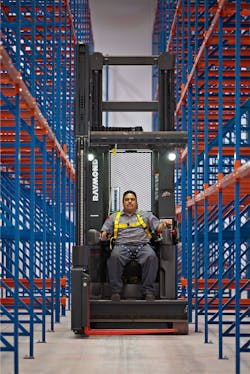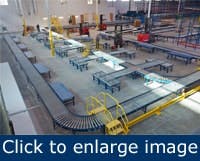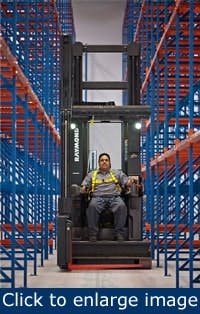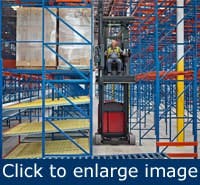Material handling meets energy efficiency
In building a new warehouse and production facility, 9 to 5 Seating (www.9to5seating.com) had a simple but aggressive goal: increase capacity to quadruple production.
The U-shaped material flow circulates goods throughout the warehouse where assembly items are delivered to a forward pick module that ultimately feeds the production area.
The company’s 100,000-sq-ft building has a material handling scheme built on interplay between automated conveyors, an order-picking system, a very narrow aisle (VNA) raw material storage system, and electric lift trucks chosen specifically for the process design.
A vertically integrated manufacturer of ergonomic office seating based in Hawthorne, California, 9 to 5 Seating’s building was completed in 2011 and has earned Gold certification under the U.S. Green Building Council Leadership in Energy and Environmental Design (LEED) program. Raymond Handling Solutions (www.raymondhs.net) of Los Angeles helped to design the handling system.
“Material handling is an important part of what we do here,” notes Dara Mir, 9 to 5 Seating president. “All of our products are made to order and ship in 48 hours, so manufacturing just in time is key to our success. It’s essential for us to have a very efficient material handling and production process.”
Founded in 1982, 9 to 5 Seating specializes in the design and manufacture of office seating for companies, schools, and hospitals. “In building our new manufacturing facility and corporate headquarters, we wanted to gain efficiencies in our material handling process and create a home where we could stay for many years to come,” says Mir. “We studied the latest technology to make sure we optimized our storage density and our entire material handling and assembly process.”
9 to 5 Seating looked at options and talked to several prospective partners before choosing Raymond Handling Solutions. “Raymond Handling Solutions helped us design the entire rack and conveyor systems and select the lift trucks,” explains Mir. “It’s a well-thought-out system with a very logical flow of product, from receiving all the way out to shipping.”
Key objectives in the handling system design included reducing the number of product touches, maximizing storage density, optimizing picking efficiency, enabling tracking of orders in process throughout the facility, and making the process as energy-efficient as possible.
[pullquote]U-shaped material flow was designed so goods circulate through the warehouse, and assembly items are delivered to a forward pick module that ultimately feeds the production area. Lift trucks receive incoming raw materials and components, feed the VNA racking system, deliver components to the pick module, and move finished goods to shipping.
“Initially, we spent quite a bit of time working to truly understand 9 to 5 Seating’s business, because there’s never one solution that really fits everybody,” says Matt McNulty, core account manager for Raymond Handling Solutions. “We wanted to make certain we understood how the products flowed through the warehouse to provide the best recommendations for optimizing the new facility.”
Warehouse space comprises about two-thirds of the footprint of the new facility, which has a 32-ft minimum clear height. “We wanted to ensure that we optimized storage,” says Mir. “One of the key factors was the number of pallet positions, and to achieve the maximum result there, we chose the VNA system using the Raymond Swing-Reach trucks to do our material put-away and kitting. For further efficiency, Raymond specified its wire-guided technology to help prevent any sort of interference or collisions with the racking.”
In the handling scheme, raw materials and some finished components such as seats and seat backs arriving at the dock are handled by operators on Raymond Model 4250 standup counterbalanced electric lift trucks.
As orders for chairs arrive, truck operators pick the necessary assemblies and components from the racking and either carry them directly to the pick module or stage them at the aisle ends for other trucks to deliver. “The pick module reduces walk-around time for our order pickers,” says Mir. “They’re able to pick faster. The product is pushed to our assembly stations, rather than pulled in, and that is very important to helping us increase efficiency there.”
Pickers in the pick module create kits for each individual chair in bar coded totes, which then are sent down the conveyor line and are automatically sorted to the correct assembly stations. The handling process interfaces with the ERP system so company personnel can determine the status of a given order at any point in the process from assembly through shipping. Once assembly is complete, a conveyor takes the chairs to the packing area, where they’re boxed or bagged for shipment. Workers use the counterbalanced trucks or Raymond Model 8400 pallet trucks to load boxed chairs into trucks.
{pb}Operators pick the necessary assemblies and components from the racking and either carry them directly to the pick module or stage them at the aisle ends for other trucks to deliver.
A Model 7400 Reach-Fork truck stores and handles corrugated material for the packing area, and a walkie stacker works with a racking system that stores rolls of chair fabric.
“One of our key goals was to reduce the number of touches per product from receiving new incoming product from our vendors to storing that product to pulling it for actual manufacturing,” says Mir. “With the new design, we’ve been able to reduce the number of handling touches by about four.”
The handling process has increased productivity compared to the previous facility by more than 40%, explains Mir. “In designing the system for 9 to 5 Seating, we benchmarked against other companies in the industry,” says Rich O’Connor, manager of storage and automation solutions for Raymond Handling Solutions. “We wanted to make sure the flow of material through the facility made the most of their space. It was a complete solution, from the wire-guided lift trucks to the layout of the storage racks, to the conveyer system and the software.”
Energy is at the heart of 9 to 5 Seating’s emphasis on holding down costs on behalf of customers and operating in an environmentally responsible manner. The company’s new headquarters and warehouse/production facility earned LEED Gold certification in part for its energy efficiency and use of renewable energy. The building derives more than 80% of its energy from rooftop solar photovoltaic panels. Raymond Swing-Reach trucks, proven to use 30% less energy than comparable models in tests overseen by U.S. Auto Club Properties, operate in the VNA storage system.
Swing-Reach trucks include regenerative lowering, in which the energy of the descending load is captured to replenish the battery, enabling the trucks to run up to 40% longer per battery charge. The battery charging system, meanwhile, is set up to take advantage of the local electric utility’s time-of-use rates. Chargers don’t turn on until the start of the overnight off-peak demand period.
The material handling conveyors use all high-efficiency electric motors. The conveyor system is broken into three zones and includes an energy management control. Any conveyor zone that is inactive after a preset time period shuts off automatically. Employees press a restart button to resume operation.
The trucks help 9 to 5 conserve energy with their regenerative lowering, in which the energy of the descending load is captured to replenish the battery.
Other green features of the 9 to 5 Seating building include:
- development of a brownfield site
- access to public transportation and special parking for low-emission and fuel-efficient vehicles
- natural lighting in the office areas
- white roof to decrease the heat island effect
- control of stormwater runoff
- water-efficient landscaping
- LED lighting throughout the office area, and integration of both motion sensors and photo cells to ensure interior lighting is on when areas are occupied and lighting is below a preset light candle rating
- recycled content used when and where possible and sourced locally, if available.
The company also takes part in the WasteWise program of the U.S. Environmental Protection Agency (EPA), aimed at reducing municipal and industrial solid waste.
9 to 5 Seating is committed to sustainable and environmentally responsible business practices. This global perspective is endorsed and executed throughout every aspect of its corporate culture, and within its warehousing, manufacturing and office facilities. The company offers products certified by the Greenguard Environmental Institute (www.greenguard.org).



